| |
MEY
The Mey is a cylindrical double-reed aerophone used in Turkish folk music. Cylindrical in
shape and made of wood, it has 7 finger holes on its front side, and one finger
hole at the back. A double reed (kamish) is used that obtains the characteristic
sound of the instrument. A tuning-bridle called "kiskach"
serves to tune the Mey and to prevent alterations in pitch of the sound. A wooden piece smilar to "kiskach"
which is called "agizlik" covers the part of the reed's mouth, when the mey is not used
in order to preserve it. The size and nature of the reed is dependent on the size and nature of the
instrument.

|
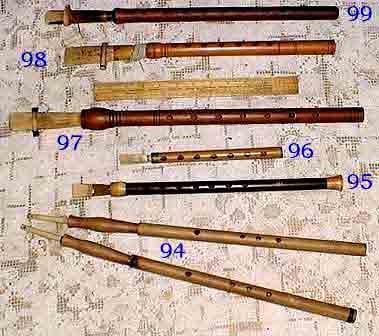 |
Photo: courtesy of Oliver Seeler / Nova Albion Research |
|
94. Auloi (a pair of Aulos) (Greece,4th centuryB.C.);
95. Kuan (China); 96. Guan (Mongolia);
97. Ana Mey(Turkey);
98. Nerme Nay (Iran); 99. Duduk (Armenia)
|
There are many instruments similar to the Mey in Asia. These are called "Balaban", in Azerbaijan, Iran and Uzbekistan; "Yasti Balaban" in Dagestan;
"Duduki" in Georgia; "Duduk" in Armenia; "Hichiriki" in Japan; "Hyanpiri" in Korea; "Guanzi" in China; and "Kamis Sirnay " in Kyrgyzstan.
Musicologists like Farmer (1936: 316) and Picken (1975: 480) have suggested
that ancient Mait, Monaulos, and Auloi present major resemblances with the Mey and the other
similar instruments. In Hellenistic Egypt, there was an instrument called "Mait"
or "Monaulos" which was similar to the Mey and there was another one in Anatolia
which was called "Auloi" and its picture was found on a vase.
In the written history of Turkish music, the oldest Turkish source regarding
the Mey is a work that dates back to the late 14th or early 15th century titled
"Makasidül-Elhan" written by Maragali Abdülkadir (ABD AL-QaDIR [ibn Ghaybi
al-maraghi]) (1350?-1435) who was a composer, performer and theorist and
traditionally considered to be the founder of Turkish music research. In this
work, the instrument referred to as "Nayçe-i Balaban" is likened to the "surnay"
which is another name of the "Zurna" and its soft and wistful sound (Bardakçi1986: 107).
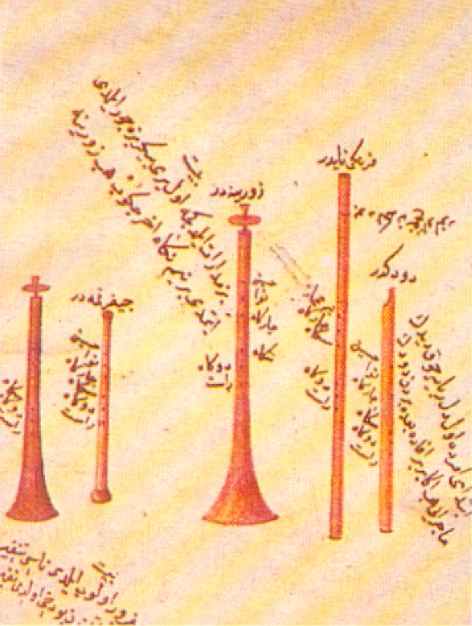
|
Evliya Çelebi (1611-1683), who lived two centuries after Abdülkadir, has
described this instrument in the following manner. He said, "The Belban (or
balaban, reed pipe of the Turkmens) was invented in Shiraz. It had no "kalak" (the
enlarging mouth of the instrument) resembling that of zurna which is double reed
Shawm. It was used mostly by Turks and there were about a hundred players in
Istanbul" (Çelebi 1314: 61). At the end of the eighteenth century, among the
instruments used in Egypt, which was then located within the borders of Ottoman
Empire, there was a detailed drawing of an instrument, closely resembling the Mey and called "irakiyye", in Aksoy's book "Music in Ottoman Empire" (Aksoy
1994:282).
The actual names "Mey" and "Balaban" are the modified forms of the term's
"nay-i balaban" or "nayçe-i balaban" which were altered through time. The suffix
"-çe" is the diminutive suffix and "nay" means reed in old Persian and so, "nayçe"
means "small reed". In some collections, we also encounter the term Mey used
alternately with the term Nay. Laurence Picken also gives it the name "mey or
nay" when he introduces this instrument in the "Folk Musical Instruments of Turkey".
He writes that "...the mey bodies which are manufactured for the Erzurum market are called nay" (Picken 1975: 475-477). As a matter of fact, another name for
"duduk" which is used in Armenia, is Nay. (Haygayan Sovedagan Sosyalistagan
Hanrakidaran.1977.Volume 3:459).
 |
Ney |
 |
Mey |
The word Nay, when modified according to the phonetics of Turkish, becomes ney, not to be confused with the reed flute "Ney" of Turkish classical music.
Therefore, most probably, the name mey is given to this instrument in order to
distinguish these two instruments.
Cevri Altintas used the Mey for the first time in 1950, during, a broadcast
on Turkish State Radio. Later, it was included in Turkish folk musical groups
and is in wide use today. Currently, because of the effects of mass
communication, the increase in the number of institutions where music education
takes place, and particularly due to the realization of the meaning and
importance of professional performance, the Mey has become widely used in almost
all parts of the country.
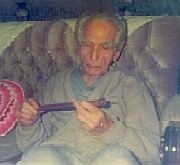
S. Y. Ataman
with C. Altintas's Mey |
This popularity has certainly caused some changes. In the 1950s, the Mey was used in just a few folk music compositions, because players used an instrument with
a range of only one octave. During the first years when the Mey was played on
Turkish State Radio, a folk song followed a solo mey performance. The performer
only had a single mey in hand and thus tuning was impossible. Later, this
problem was solved with various sizes of mey(1) . Ataman, the folk music
researcher, (1906-1994) confirmed this situation and exhibited Cevri Altintas's
mey which was in his collection.
 |
Meys in different sizes
|
|
In initial studies, according to the information and drawings in their
books, the composer and musicologist Saygun (1937: 50), and musicologists
Ülgen (1944: 36) and, Gazimihal (1975: 74) mentioned that before the
modification process, the mey had a total of 9 finger holes, 8 on the
front and one at the back, but later studies did not verify this
information. It is, however, interesting that similar instruments played
in neighboring countries have 9 finger holes. According to my own findings
and those in the literature, the size of the mey is approximately 30 cm.
After the modification process in 1961, according to the information
obtained from Binali Selman, a famous mey player, three sizes of mey were
being played: ana (the largest size), orta (middle), and cura (the
smallest) (Picken, 1975:476) This classification has been valid for many
years. Until the 1990s, these three sizes of mey have been used and by
means of the reed and bogaz "adaptor," one tries to solve the problem of
tuning the mey with other instruments. In the resulting heavy demand,
Ayhan Kahraman, the manufacturer of the instruments, produces 8 separate
sizes of mey each corresponding to a diatonic sound. A Tonic in the
Instrument corresponds to each sound of the piano. In this Turkish folk
instrument in which the possibility of transposition is limited, it is
necessary to change the mey whenever the key changes.
The mey is found widely in the eastern region of Turkey (2). Here, this
instrument, however, it is no longer used in some provinces and in same cases is
played in other provinces (3).
The structure of the mey is most suitable for the character of
the music of the East Anatolia. It has a non-strident sound, and for this reason, it is preferred for
indoor use. Most of the Mey players in Turkey can also play the Zurna. They
usually have a lower social status and most of them are wedding musicians. The
social status of the players, however, has been somewhat improved.
The role played by the Zurna in outdoor is carried out by the Mey indoor.
The "Def" or sometimes a second Mey generally accompanies it.
While one of the Meys plays the tune "ezgi", the other sustains a drone called
"dem". It takes the place of an accompanying instrument when played by groups;
and used to play before the tunes, "taksim" improvisation which is also called "yol gösterme",
"gezinti", or "açis". Its mellow and wistful sound is consistent with these
forms. It has also been used as a minstrel's instrument, or "ashik sazi". We can
observe a typical example of this in Aga Keskin who is a mey player (4). The
artist first plays the mey, and then sings the song while the mey is silent; he then takes
the mey again to continue the tune.
Because the range of the instrument is limited to one octave in order to play
a scale, sounds are produced by means of the fingers and lips and only certain
modes (makams) may be played (5).
HOW TO PLAY THE MEY
When playing the mey, the left hand should be above and right hand below the
instrument. The little finger of the left hand and the thumb of the right hand
are not used. Continuous vibrato is heard when playing due to the use of a big
reed. When the player wants more vibrato, however, he either vibrates his jaw
with rapid intervals or shakes the instrument with both hands. One of the most
important things a mey player should achieve is to play the tune continuously,
which necessitates circular breathing.
STRUCTURE OF THE MEY
The body of a mey is generally made of plum wood. Although the preferred wood
is from the plum tree, other trees such as walnut, mulberry, beech, apricot,
acacia, olive, and rose are also used. Recently, wood imported from Africa is
also used.
The top opening of the mey where the reed is inserted, is twice the size of
the bottom. The diameter of this opening is between 10 and 20 mm. in the largest
size of the mey. It is from 10 to 18 mm. in the smallest mey. A large reed is
used for a large sized mey, and small reed is for the small sized mey. If the
drone is not sustained, a disturbance occurs in the sound. The finger holes are
in equal distance from each other and their diameter is 6 mm. in all sizes of
meys.
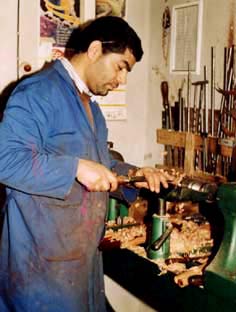
Mey body production |
When we inquire about the master craftsmen who make their meys
themselves in Anatolia. Even if some masters manufacture their
instruments, very few of them earn their livelihood in this way. Among
these masters (usta), the oldest and best-known was Dikran Nisan of
Diyarbakir who was called Niso Usta (6). The other masters, who used to
make meys in Anatolia, were Master Tosun in Pasinler and Master Hakki in
the Erzurum province. These two masters managed to be manufacturers of
meys besides being carpenters. (Isikli, 1992). The mey player who is
called Cabbar, in the province of Artvin, manufactures it with a
manual-lathe similar to the master craftsmen mentioned above.
Today, primarily in Istanbul, the manufacture of the meys and zurnas
has become a thriving business. There are 4 manufacturers who produce the
instruments These include the master craftsmen Hasan An in Tahtakale,
Aydin Konuk in Edirnekapi, Ali Riza Acar in Esenler, and Ayhan Kahraman in
Ümraniye. They all use electric lathes, but the only one among them who
exhibits quality work is Ayhan Kahraman who has produced instruments since
1980, and plays the mey and the zurna quite well. He continuously improves
manufacturing techniques for his instrument and uses good quality
materials (7).
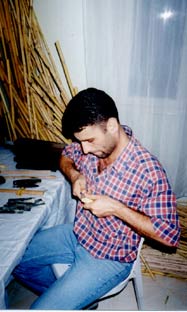 |
Reed (kamish) production
|
The mey reed are made from fresh water reeds, their length varying
approximately between 80 mm. to 150 mm., the mouth of the reed between 20
mm. and 40 mm. The sound characteristic of the mey is obtained by its long
and large reed. One end of the reed, which is cut through its joint
(knot), is flattened to fit into the players' mouth. The other end is left
round as is the original shape of the reed. This end is inserted into the
head - part of the mey which is enlarged for the reed. The reed is left
thick in the part to be inserted into the mey, or it is made airtight with
waxed threads. Some modifications appear in mey bodies as well as in the
reed structure. In the reed structure, in the past, the reeds were used by
making a knot with threads in a place near the lower region (Isikli,1992).
The reed manufacturer Sehamettin Tekin has confirmed this (Tekin 1992).
The researcher Cemil Demirsipahi has drawn pictures of mey reeds with
tuning - bridle (Kiskaç) and with thread (Demirsipahi 1975 194). Another
interesting finding is that the aulos and monaulos reeds belonging to the
Hellenistic period of Egypt were with joints (knots).
The tuning - bridle (kiskaç) which is mounted on the mey reed is made
of a wood piece, and is bound on both sides. It not only makes the playing
of the mey comfortable but also is used for the adjustment of the sound
tone and tuning. Until recently, their players made their own reeds, as
well as their instruments. With changing living conditions and the
increase in the number of players, some of them have turned to the
manufacture of reeds. The oldest known reed manufacturer is Sehamettin
Tekin who is now too old to produce reeds. Tekin has stated that he
learned how to make reeds from Aga Tastan, and that the reed shapes in use
nowadays owe their popularity to his school of reed production. (Tekin
1992). Currently, Mehmet Simsek and Dursun Kement in Istanbul and Ali
Zeynel Çiftçi in the Hatay are making reeds.
THE MODIFICATION PROCESS OF THE MEY
As a graduate of the Turkish State Conservatory of Music in Istanbul, I was
schooled in both Western and Turkish traditional musical systems. As a result of
this bimusical background, I play Western flute as well as the mey. The
familiarity with the flute performance practice inspired me to explore the
possibilities of modifying the mey in order to overcome its technical
limitations which have led to problems in executing specific intervals,
transposition, and modulation.
I sought to achieve these goals by working with an instrument maker in
Istanbul who was open to experimenting with methods of extending the range of
the instrument and changing the nature of the large double reed. Attempts to
accommodate more scales by manipulating the reed proved to be unsuccessful as
the unique mellow sound of the instrument would be altered significantly.
Despite this success in producing a new and evolved mey, and the ability of
instrument to perform a full range of folk music repertoire, there has been some
resistance from traditional folk musicians.
There have been no significant changes in the physical structure of the
mey. Only its present state has been adjusted to current conditions. I
tried to improve the structure of the mey, and while realizing this, I
tried not to spoil its unique sound. My aim was to improve the sound and
the range of the mey. First, I tried to obtain an octave or five tones
from the same sound hole, similar to over-blowing a flute or clarinet.
Because the reed, however, is double-sided and large, this was not
possible. It was necessary to change the structure of the reed, and this
would spoil the original sound of the instrument. Second, I tried to
obtain a larger range by drilling holes in the reed, to extend the
fingering but this was not possible. Later, by placing keys on the body of
the instrument it was possible to increase the range by an octave and a
forth and to produce semitones and microtonal pitches.
|
|

